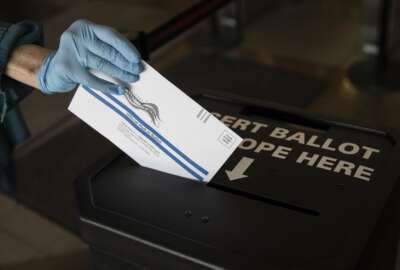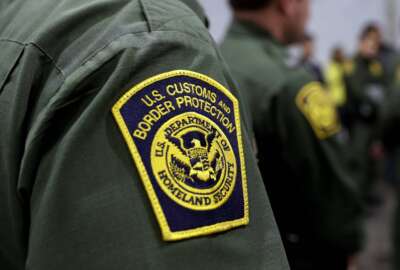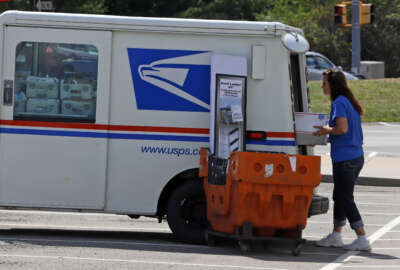USPS sees more on-time holiday deliveries, despite surge in COVID-19 quarantines
The improved performance is a positive sign for USPS management. However, the latest COVID-19 quarantine figures indicate USPS will continue to contend with...
The Postal Service, during its busiest season, is seeing an uptick in COVID-19 quarantines among its workforce.
Despite this challenge, USPS data shows the agency provided a significantly higher level of service this year, compared to widespread mail and package delays it saw in December 2020.
USPS data shows it delivered more than 90% of first-class mail on time so far in the first quarter of fiscal 2022. That’s a significant improvement, compared to the 78.44% of first-class mail delivered on time for the same period in FY 2021.
One possible factor behind these improved metrics, however, is a new service standard for first-class mail USPS implemented on Oct. 1 that allows the agency to add an extra day or two for mail delivery and still consider it on-time.
The improved performance is a positive sign for USPS management, which ramped up preparations for its peak holiday operations earlier than normal. However, the latest COVID-19 quarantine figures indicate USPS will continue to contend with employee availability issues well into 2022.
The American Postal Workers Union (APWU) reports more than 6,500 USPS employees, as of Dec. 24, were out of work because of COVID-19 infection or exposure. An APWU official told Federal News Network that these figures mark the highest quarantine rate for USPS since September this year.
The current number of employees in quarantine, meanwhile, is less than half of where USPS stood in December 2020, when as many as 19,000 postal workers were under quarantine.
USPS spokeswoman Darlene Casey said the agency does not comment on the existence of positive employee COVID-19 cases in postal facilities, or in quarantine, due to privacy concerns.
However, Casey said USPS “has resources in place, including adequate staffing in postal facilities across the country, to meet the service needs of our customers during the holiday season.”
The Washington Post first reported the latest quarantine figures on Monday.
APWU data shows total quarantines among the USPS workforce hit a low point on June 28, when fewer than 2,600 employees were out on leave. Those quarantines, however, exceeded 3,200 by late July.
For context, the current number of USPS employees having to quarantine is barely 1% of the agency’s total workforce of 644,000 personnel. However, Postmaster General Louis DeJoy and other USPS senior executives have cited employee availability as a leading concern for much of the pandemic.
In response to last year’s mail and package delays, USPS began ramping up for its peak holiday season this summer, earlier than it would normally begin preparations.
USPS converted more than 63,000 pre-career employees to career positions, in an effort to reduce workforce turnover, and hired more than 185,000 employees since the beginning of last fiscal year, including 40,000 seasonal hires.
“In a year when the COVID-19 pandemic has been so devastating to the country, the Postal Service has delivered for the public in every community,” DeJoy said in a short speech Monday before ringing the opening bell at the Nasdaq stock exchange.
USPS also installed 112 new package sorting machines and leased 13 million square feet of additional space at more than 100 locations to deal with an ongoing surge in packages. These investments allow USPS to process an additional 13 million packages every day.
The Postal Service, as an independent agency, is not subject to the Biden administration’s vaccine requirements for the federal workforce.
It is, however, subject to the Occupational Safety and Health Administration’s (OSHA) COVID-19 Vaccination Emergency Temporary Standard (ETS), which requires all employers with 100 or more employees to ensure their workforces are fully vaccinated or show a negative test at least once a week.
The Supreme Court will hear oral arguments on Jan. 7 to determine whether the Biden administration can proceed with the OSHA vaccine mandate, the Associated Press reports.
OSHA has said the vaccination mandate will go into effect on Jan. 10, while the testing requirement deadline is Feb. 9. OSHA, in a statement on its website, says it will not issue citations before those dates “so long as an employer is exercising reasonable, good faith efforts to come into compliance with the standard.”
USPS IG finds late mail volume over-reported at processing sites
While USPS is demonstrating a higher level of on-time performance, a recent report from its inspector general finds the agency isn’t making the most of a new system meant to provide near real-time data on mail delays and conditions at its processing facilities.
A USPS OIG report earlier this month found management at the processing and distribution centers (P&DCs) it reviewed were not using the USPS data dashboard as intended.
USPS stood up the Mail Condition Visualization (MCV) system in January 2019 to provide near real-time visibility of mail conditions at processing facilities. The system determines how much late mail there is at any processing center, based on the scans each piece of mail gets coming into the facility and when it leaves the facility en route to a post office.
The IG report, however, found a significant volume of mail didn’t receive an outbound scan at the processing centers it audited, which resulted in the MCV system showing a significantly higher inventory of late mail, compared to daily mail inventory counts that processing center management conducted each day by hand.
The USPS IG audit found that, for example, a processing plant in Raleigh, North Carolina, over-reported the inventory of late mail by more than 92% over a five-day work week in June, while a processing center in Denver, Colorado, over-reported late mail by 88%.
“As a result, P&DC management was unable to rely on the data to determine if there were actual delayed mail conditions at the facility and did not use the MCV data to measure their performance and make operational decisions,” the report states.
USPS OIG found that management at processing centers “did not know the causes for the high amounts of delayed inventory reported in the MCV system because they did not fully understand how delayed inventories were calculated.”
USPS IG found that management at eight processing centers “was more concerned if mail was actually delayed and remaining on the workroom floor,” and conducted daily, manual counts of delayed mail to get a more accurate representation of mail conditions at their facilities.
An additional 19 processing centers told USPS OIG that they were also conducting daily delayed mail counts “because they found that the data in the MCV system was not reliable.”
“As a result, P&DC management was unable to rely on the data to determine if there were actual delayed mail conditions at the facility and did not use the MCV data to measure their performance and make operational decisions,” the report states.
USPS IG said daily delayed mail counts were supposed to end when it launched the MCV system. USPS estimates this process takes an average of three hours a day per facility. It was estimated that eliminating these manual checks would save $9.4 million in FY 2020 and $9.6 million in FY 2021.
“Since P&DC management is still relying on daily delayed mail counts, workhour savings forecasted are not being fully realized,” the IG said.
The IG report recommends USPS provides additional Mail Condition Visualization training to local processing management on how to use the system to “identify root causes for delayed inventory to provide a more accurate representation of mail conditions at the facility.”
USPS Vice President Processing and Maintenance Operations Mike Barber, however, said USPS management disagreed with all the report’s recommendations, as well as some of its claims.
“USPS disagrees with the statement that management did not fully understand or use delayed inventory data. There was no supporting documentation in the audit for the determination. Plant Managers and Division Directors understand the data and the limitations. Plant Managers make the decisions necessary to protect service,” Barber wrote.
Barber told the USPS IG office that management is already providing “robust MCV training” and that local management has “legitimate reasons” for sending mail out from processing centers without a final, outbound scan.
“Timely delivery of the mail takes precedence over accurate reporting,” Barber wrote.
Copyright © 2025 Federal News Network. All rights reserved. This website is not intended for users located within the European Economic Area.
Jory Heckman is a reporter at Federal News Network covering U.S. Postal Service, IRS, big data and technology issues.
Follow @jheckmanWFED






